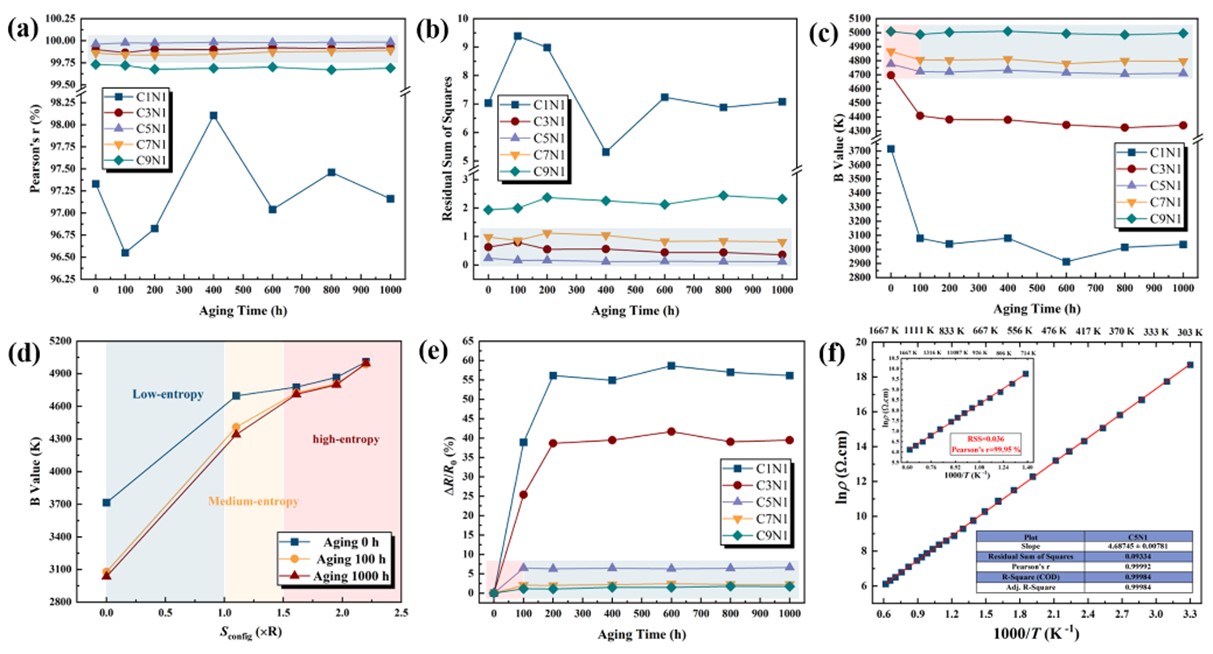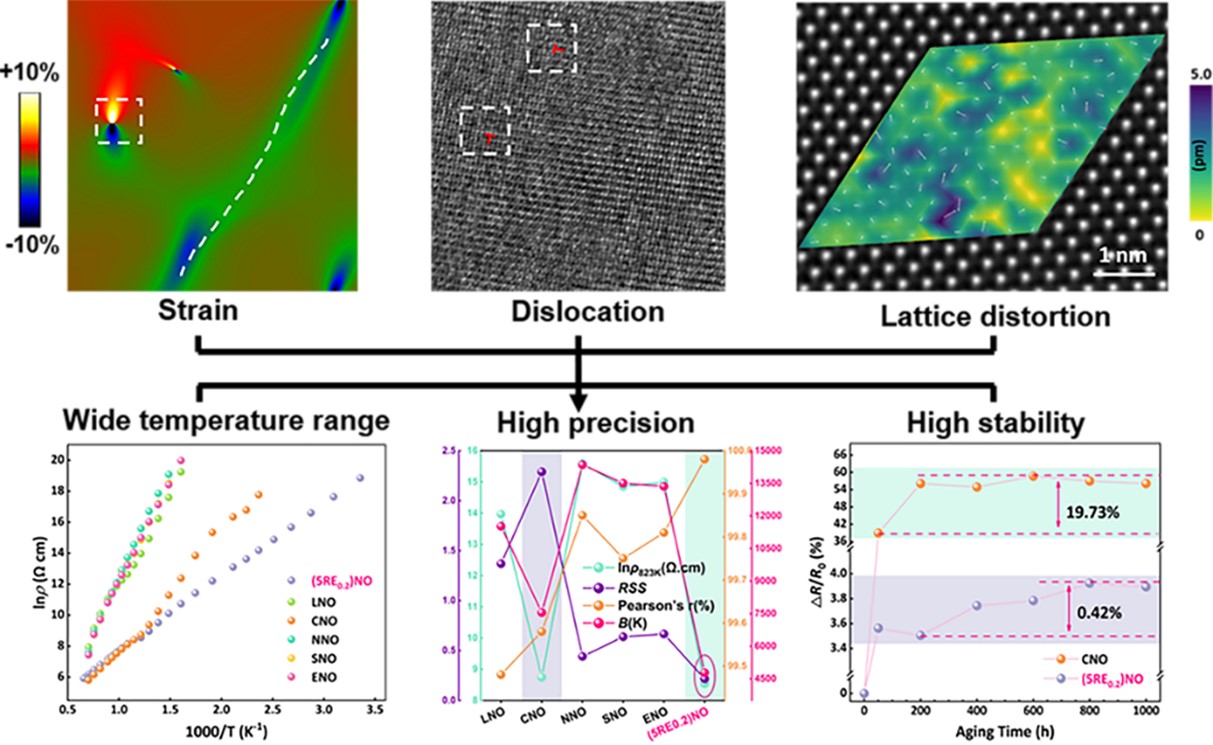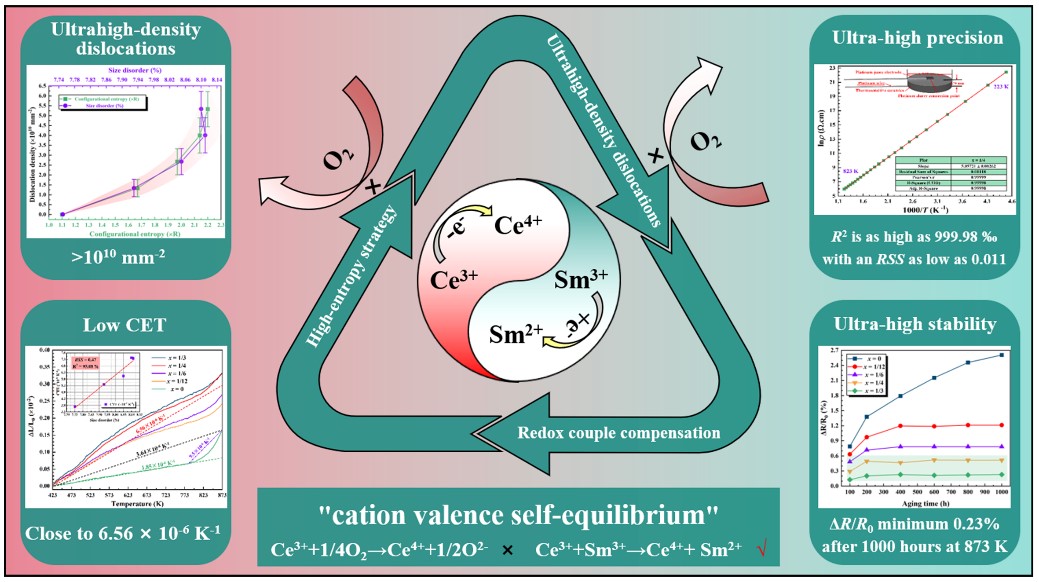High entropy strategy facilitates the breakthrough of performance ceiling for CeNbO4+δ-based high-temperature thermosensitive ceramics
Editor: | Jul 08,2024
With the rapid development of the global manufacturing industry towards high, precision, and advanced direction, high-performance high-temperature thermistor sensors play a positive role in promoting the efficient utilization of fossil energy, high-temperature measurement, and control of key aerospace components. Compared to traditional temperature sensors, negative temperature coefficient (NTC) thermistors have significant advantages due to their high precision, fast response, low cost, small size, long life, low thermal inertia and strong overload capacity. However, how to synergistically regulate the high-temperature stability and electrical transport performance has become a key bottleneck restricting the development of high-temperature thermistor sensors.
CeNbO4+δ ceramics have typical NTC thermosensitive properties, high melting points, and strong structural tolerance, making them one of the important high-temperature thermosensitive ceramics. However, their inherent structural transformation and stoichiometric deviation lead to complex structural changes, sudden changes in electrical transport performance and poor high-temperature aging performance, which restrict their further development and application.
Recently, researchers from the Xinjiang Institute of Physical and Chemical Technology, Chinese Academy of Sciences, researched the problem of coordinated regulation of wide temperature range and high-temperature stability of CeNbO4+δ-based high-temperature thermosensitive ceramics. The research team introduced an excess of rare earth ions into CeNbO4+δ-based solid solution ceramics based on the unique lanthanide contraction properties of rare earth elements. The effects of the composition, size disorder (δ), and configurational entropy (ΔSconfig) on properties were evaluated to promote the rational design for improving the performance of high entropy ceramics (HECs). The prepared ceramics can overcome the potential conflict between high electrical resistivity (ρ) and low material constant (B), and achieve excellent NTC characteristics in an extremely wide temperature range from room temperature to 1623 K (i.e. 1350 °C). The determination coefficient (R2) of the resistance-temperature (lnρvs 1000/T) relationship was as high as 99.98%. The ceramics maintained excellent high-temperature stability during long-term high-temperature aging, with a resistance drift rate (ΔR/R0) as low as 0.17% after aging at 1273 K (i.e. 1000 ℃) for 900 hours. This study provides a new approach for the synergistic regulation of high stability and wide applicable temperature range. The related achievements have been published in Journal of the European Ceramic Society (2024, 44: 311-318. https://doi.org/10.1016/j.jeurceramsoc.2023.09.001).

Figure 1. High-temperature stability of CeNbO4+δ-based thermosensitive ceramics by high entropy configuration In addition, the research team also utilized a high entropy strategy to introduce rare earth elements lanthanum, neodymium, samarium, and europium into CeNbO4+δ-based oxides. By inducing lattice distortion and high-density dislocations, the transport capacity of charge carriers was effectively enhanced and the grain boundary potential barrier was reduced, thus significantly expanding the applicable temperature range. Researchers conducted an in-depth analysis of the phase structure characteristics of (La0.2Ce0.2Nd0.2Sm0.2Eu0.2)NbO4 for high-temperature applications, and quantitatively evaluated stress distribution through microstructure analysis, thus revealing lattice distortion patterns. The relationship between structural distortion caused by high configuration entropy and physical properties was elucidated, and the effectiveness of the high entropy strategy in optimizing the properties of high-temperature thermosensitive ceramic materials was verified. The prepared (La0.2Ce0.2Nd0.2Sm0.2Eu0.2)NbO4 high entropy ceramics maintained an extremely low resistance drift rate(ΔR/R0 only 0.42%) after aging at 1173K (i.e. 900 ℃) for 1000 hours, and the applicable temperature range was extended from room temperature to 1523 K(i.e. 1250 ℃). The related achievements have been published in ACS Applied Materials and Interface (2024, 16:12821-12832. https://doi.org/10.1021/acsami.4c00187). Figure 2. Structure-activity relationship between microstructure and thermosensitive properties of (La0.2Ce0.2Nd0.2Sm0.2Eu0.2)NbO4HECs
To comprehensively solve the problems of poor stability, narrow applicable temperature range, and low temperature measurement accuracy caused by the stoichiometric shift and structural transformation of CeNbO4+δ ceramics. The research team used the dual cation equivalent site configuration entropy co-configuration strategy to establish controllable and thermodynamically stable high-density edge dislocations (>1010 mm-2) in Ce1-2x(SmNb)x(VNbTa)1/3O4+δ ceramics based on the unique entropy stability, lattice distortion, and multi-element synergistic effects of high entropy ceramics. A "cation valence state self-equilibrium" system was constructed through the organic combination of thermodynamically stable high-density edge dislocations and oxidation-reduction coupling compensation. This system synergistically solves the problem of oxygen nonstoichiometric ratio and temperature dependence from the source and pathway. Meanwhile, the highly disordered structure avoids the accumulation of orientation stress and thus eliminating structural transformation. The prepared ceramics exhibited excellent thermal sensitivity in a wide temperature range of 223 - 823 K(i.e. -50 - 550 ℃), with an R2 of up to 999.98 ‰, and a residual sum of squares (RSS) as low as 0.011. After aging at 873 K (i.e. 600 ℃) for 1000 hours, the minimum value of ΔR/R0 was 0.23%. Compared with the latest research progress in high-temperature thermosensitive ceramics, the temperature measurement error has been reduced by more than 10 times while maintaining excellent high-temperature stability. The related achievements have been published in ACS Applied Materials and Interface (2024, 16: 28861?28873.https://doi.org/10.1021/acsami.4c04696).

Figure 3. Structure-activity relationship between "cation valence self-equilibrium" system and thermosensitive properties in Ce1-2x(SmNb)x(VNbTa)1/3O4+δ ceramics Through the above work, the research teams not only successfully solve the problems of poor stability, narrow applicable temperature range, and low temperature measurement accuracy caused by the stoichiometric shift and structural transformation of CeNbO4+δ ceramics, but also analyze the reasons and propose corresponding scientific solutions, which provide important references for optimizing the properties of high-temperature thermistor ceramics. The above research works were supported by the Youth Innovation Promotion Association of the Chinese Academy of Sciences, the Xinjiang Tianshan Talent Training Program, the West Light Foundation of the Chinese Academy of Sciences and the National Natural Science Foundation of China, etc. Contact: Bo Zhang State Key Laboratory of Functional Materials and Devices for Special Environmental Conditions, Xinjiang Key Laboratory of Electronic Information Materials and Devices, Xinjiang Technical Institute of Physics & Chemistry of CAS, Urumqi, China E-mail: zhangbocas@ms.xjb.ac.cn Key words: high-temperature thermosensitive ceramics; high-entropy; wide temperature range; high stability
附件下载:
 (86) 991-3838931
(86) 991-3838931 lhskj@ms.xjb.ac.cn
lhskj@ms.xjb.ac.cn (86)991-3838957
(86)991-3838957 40-1 Beijing Road
Urumqi, XinjiangChina
40-1 Beijing Road
Urumqi, XinjiangChina